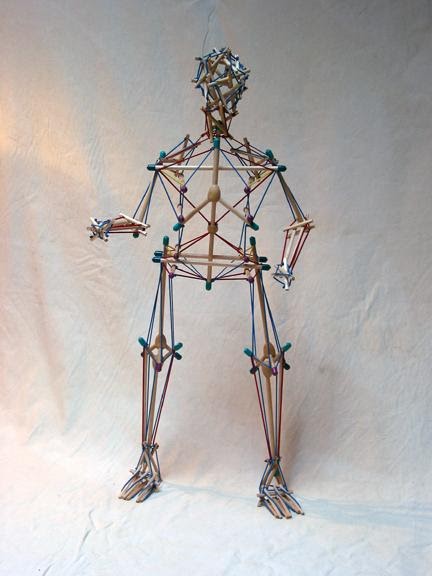I use myofascial techniques fairly extensively in my practice, yet this terminology may be foreign to some of you. Following provides some anatomy background and a discussion of why this has personally become such an important approach. First a couple definitions:
Definition of Myofascial
Myo – meaning muscle
Fascial – pertaining to fascia
Myofascial – addressing the fascia found throughout the body, notably invested in and wrapping around muscles. As described by Howard Rontal myofascial tissue is continuous and omnipresent in the body. It interweaves and wraps muscles, and every division of tissue within the muscle. By weight, 40% of a muscle is actually fascial tissue.

The importance of fascia cannot be overstated at it brings structure to our assemblage of muscle and bone while helping muscles, tendons and ligaments move smoothly alongside each other. Fascia provides the tension around muscles and across joints, much as Buckminster Fuller’s tensegrity models are able to take form.
These are the reasons we must take care of both our fascial and muscular system.
And there’s more… Fascia contains “ground substance”, which can become dehydrated and make the fascia itself sticky. One role of fascia is to keep muscles moving past each other. Obviously when it becomes sticky, this can inhibit movement. Fascia also contains nerves and blood vessels that connect to muscles. It is easy to imagine that if fascia becomes sticky and is not moving well then innervation (nerve signals) and circulation may also be affected. Again, from Howard Rontal, where “there is chronic or acute pain, limited or difficult range of motion, ongoing stress and tension, there is almost always myofascial tissue which needs to be released and relaxed.”
Fascial release allows for muscle realignment and relaxation, resulting in improved postural balance, range of movement and reduction in pain. A 2021 study on myofascial release and its effects on low back pain by Christine Lohra and Ivan Medina-Porqueres in Clinical Biomechanics suggests that myofascial release alters neuromechanical characteristics in subjects with low back pain, improving muscle efficiency (and reducing pain). The results showed that 6 minutes of myofascial release created changes in the erector spinae muscles’ neuromechanical characteristics, especially in participants with lower back pain. In particular, there was a significant increase in the velocity of contraction, a measure of muscle contraction speed, on both sides of the lumbar erector spinae for participants with lower back pain, but not for the healthy controls.
Clients experience myofascial work as a “no lotion” massage–the use of the therapist’s hands, forearms or elbows that creates heat and a stretching of skin and muscle directly beneath– it may also involve the client moving a body part while the therapist “pins” a muscle. Myofascial techniques are recognized and utilized by other professions including Physical Therapists, Chiropractors, Rolfers and other bodyworkers.
So that’s the definition of myofascial and a bit about fascia. So why choose myofascial work?
No lotion allows a more detailed sensing of the tissue
This in turn allows for a more detailed treatment approach. Lotion allows you to glide over skin. When I DO NOT use lotion, my hands will glide over mobile tissue and actually stop gliding when I hit immobile tissue. I can also feel tighter or ischemic areas (low circulation) which produce trigger points, as well as a refined definition of each muscle and their associated tendons.
I am inspired by and draw heavily from Til Luchau at Advanced Trainings for my myofascial work. In general Til’s work focuses on:
• Specific techniques for commonly encountered complaints
• Relieving pain, restoring lost function, and getting lasting results
• Utilizing both active and passive movement to enhance effectiveness
• Precision in working with specific tissue types and body layers
• Combining indirect or subtle work with deep or direct work
• Ways to work sensitively, safely, and comfortably at all levels of depth.
More specific to each person’s needs
Myofascial release work is as varied as many bodywork techniques. My training and experience ranges from more traditional approaches as taught by Howard Rontal, to a broader range of techniques as developed by Til Luchau. Til’s program draws from a wide range of disciplines. The focus is on unusual, interesting, and fresh approaches that increase effectiveness, expand technique repertoire, and inspire creativity and innovation.
I tend to use techniques developed by Howard Rontal on larger muscle groups and for rib, diaphragm and ab work. I then break out my Advanced Trainings tool kit for joints and smaller muscle work. They are all designed to hydrate tissue and increase movement options. For example, I use long, slow broad strokes along the back for the long erector muscles, while the calf and lower leg requires more detailed work, often including movement from the client.
So that’s a bit about myofascial techniques. If YOU have a technique, body part, muscle or system that you’d like to hear more about, drop me a line!

